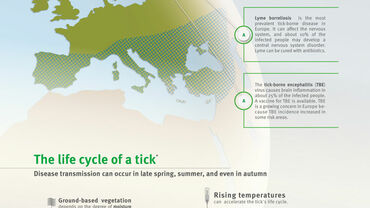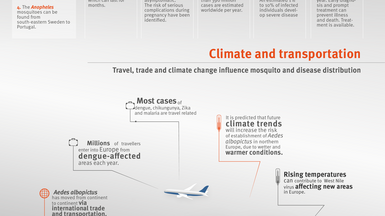Key messages - Vector-borne diseases
- Vectors are small organisms such as mosquitoes or ticks that can carry pathogens from person to person and place to place.
- Personal prevention measures and vector surveillance and control at country level are key to prevention and control of vector-borne diseases.
- ECDC evaluates the risk to the EU of emerging vector-borne diseases by issuing risk assessments on outbreaks occurring in Europe or EU overseas territories. It also implements regular surveillance on vector-borne diseases, such as West Nile fever and tick-borne encephalitis.
- Vector-borne diseases rely upon organisms, named vectors, such as mosquitoes, ticks or sandflies that have an active role in the transmission of a pathogen from one host to the other.
- Many factors may facilitate the introduction and establishment of disease vectors, reservoirs or pathogens in new geographic areas and could lead to the emergence of a disease in Europe: international travel and trade, e.g. legal and illegal trade in animals and animal products, new agricultural practices and land-use patterns, socio-demographic evolution and climatic changes.
- Climate change, international trade and travel influence the distribution of vector-borne diseases in Europe.
- International trade and travel are the main factors that might drive the emergence of ‘tropical’/emerging diseases in Europe.
- Climate change can influence the establishment and transmission of new pathogens and vectors.







